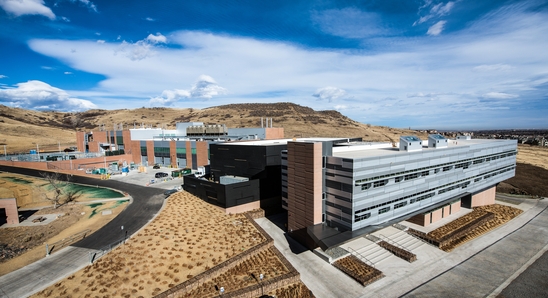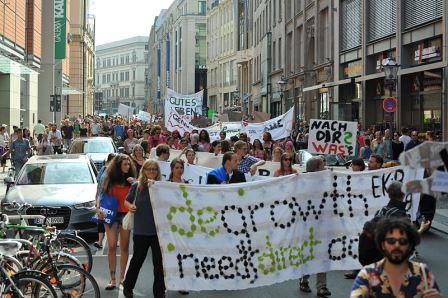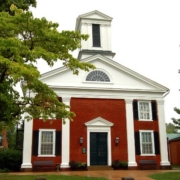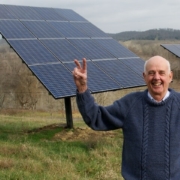The Steady Stater Stance on Renewable Energy: A Clarification
By Brian Czech
Ever since my review of Michael Moore’s Planet of the Humans, some misunderstandings have come to light about the stance of myself, and by extension CASSE, on renewable energy. One such misunderstanding—spread far and wide—is that we are “against renewables.” A clarification is definitely in order.
CASSE and steady staters at large are all for renewable energy. Of course! Along with the steady state economy as the sustainable alternative to growth, renewable energy is the sustainable alternative to fossil fuels. What we oppose is the fallacious notion of “green growth” that has come to dominate pro-renewable political discourse. We also oppose the wholesale, automatic acceptance of any and every wind and solar project; not everything touted as “green” turns out to be ecologically economic. Along those lines, we certainly don’t support the liquidation of biomass stocks that otherwise provided crucial ecosystem services.
We also suggest putting the political horse before the technological cart. As I, Herman Daly, and Bill Rees have each pointed out independently, a sustainable shift to renewables must follow a conscious, intentional adoption of the steady state economy (entailing a phase of de-growth) as a policy goal. Otherwise, with the goal of economic growth ruling the policy arena, renewables and nuclear plants will be used to supplement rather than replace fossil fuels, and the resulting amount of destructive economic activity will only increase. Adding insult to injury, not only will the destruction on the ground increase, but greenhouse gas emissions as well!

As long as GDP growth is the goal, renewable energy will add to—not replace—fossil and nuclear plants. (Image: CC0, Source)
That said, a certain amount of respect is due those who are so passionate to save the planet that they’ll do just about anything, as soon as possible, for a transition to renewables. As with passionate people in other walks of life, they can be obsessive and zealous. It’s hard to blame them, because climate change is a current psychological threat as well as a mounting existential one. They lose sleep at night (well-documented especially in children) and develop ulcers over the relentless forcing of greenhouse gases into the precious atmosphere of our common home. They are ready to go to verbal war (and maybe more) with anyone who detracts—or who they think detracts—from the transition to renewable energy. They are in some ways heroic and tragic figures, as haunted by the fossil-fueled world as steady staters are by the pro-growth world.
Furthermore, some are doubly haunted. That is, they fully acknowledge the need for a steady state economy as well as renewable energy. Yet, not abiding the wisdom of Daly that “sequence matters,” their days are spent not in advancing the steady state economy but rather in developing renewable energy technology, designing renewable energy projects, or pushing politically for renewable energy. Maybe they hope that others will prevail in advancing the steady state economy, such that solar and wind actually replace rather than supplement fossil fuels.
The decision for any one person or organization about what to prioritize—advancing the steady state economy or advancing renewables—entails a number of factors. One such factor is the technical background of the individual. All else equal, someone whose expertise is primarily in renewable energy is better suited to advancing renewables. If the background is in ecological economics, then advancing the steady state economy is a better fit.
Another factor is age. A young renewable energy scholar who concludes that advancing the steady state economy is the first order of business may find it feasible to steer further academic and professional development toward advancing the steady state economy. An elder statesman of renewable energy may not.
As other factors come into play, almost all steady staters conduct a mix of advancing the steady state economy and renewable energy, but with a decided emphasis on the former. Indeed, it would seem to be the emphasis on advancing the steady state economy that makes one a “steady stater.”
Aside from one’s expertise and age, two other prioritization factors warrant a closer look. One is the marginal benefit of “steady statesmanship” vs. renewable energy action. Which offers the biggest bang for the buck? Another is an overlooked ecological footprint; we’ll follow it among the technological trees while remaining cognizant of the sustainability forest.
Biggest Bang for the Buck
How many people and organizations support renewable energy? Could we even stop counting? We could go on and on, starting with steady staters and moving into ever-widening circles of sustainability scholars, environmental activists, professional scientific societies, little environmental NGOs, big NGOs, and even many corporations, utilities, and politicians. Most importantly, it includes a substantial share of the general public, and even most nations!
Now, how many people and organizations support the steady state economy? Again we can start with the steady staters. Next, we can include a fair number of sustainability scholars and environmental activists, plus a tiny number of environmental NGOs and a handful of professional scientific societies. That’s about where it stops. So far we haven’t been able to get a Pew researcher, much less a Roper poll-taker, even interested in the steady state economy, so we have only a vague idea what the general public thinks. This is one of the main reasons we strive to obtain signatures on the CASSE position on economic growth; to demonstrate public support for the steady state economy, empowering NGOs to tell it like it is about limits to growth, and empowering politicians to support steady-state policies such as the Full Seas Act. While the current number of almost 15,000 signatories is nothing to sneeze at (especially given such notable signatories) it must be millions if not billions less than the number of people who support renewable energy.
So, if you are a student, scholar, activist, or philanthropist wondering which activity—advancing the steady state economy or promoting renewable energy—needs more help and offers a higher marginal benefit from your studies, scholarship, action, or philanthropy, consider the proportions above. Unless you believe in “green growth,” it should be more obvious by the GDP-bloated day that the bigger bang for the sustainability buck comes from advancing the steady state economy.
Technological Progress: The Forgotten Footprint
There is room for disagreement about how much additional, destructive GDP will transpire as renewable energy is added to the mix of fossil, nuclear, and (semi-renewable) hydrological sources. Clearly there will be additional destruction as long as GDP growth is the overriding domestic policy goal, but the destruction can be lessened to the extent that steady statesmanship prevails. Moderate success in steady statesmanship reduces the GDP growth rate. Full success is when the steady state economy is recognized as an a priori goal and deliberately accomplished with effective policies. With fully successful steady statesmanship, the ecological footprint from renewable energy may be offset by a reduced footprint from non-renewable energy. How will this happen, though, if advancing the steady state economy is the exercise of such a small minority?
Meanwhile, arriving at ever-higher proportions of renewable (as opposed to fossil) energy entails its own ecological footprint. This is an ecological footprint quite beyond that of the activities fueled by renewable energy. For starters, we have the obvious ecological and economic costs of retrofitting the fossil-fueled grid and the energy system at large. These costs includes the surveying, excavation, construction, and circuitry entailed in the development of wind and solar harvesting and delivery facilities. It also refers to the demolition of fossil-fueled plant and infrastructure, plus the disposal and replacement of fossil-fueled implements and appliances en masse. For example, approximately 40% of American homes have gas stoves, which means about 50 million stoves must be replaced or retrofitted in the USA alone to convert (on a one-to-one service basis) from fossil-fueled power to renewables.
Now let’s dig a level deeper. What about all the analyses, presentations, meetings, conferences, slideshows, websites, videos, magazines, community relations campaigns, planning, lobbying, negotiations, settlements, legislation, subsidies, loan assistance, bureaucratic reorganization, personnel management, tax reforms, and regulations that have been and must be devised and performed for purposes of moving the energy system toward renewables? These were, are, and by no means will be cheap. We might loosely call these “transaction costs.” Don’t take the wrong point from this; the transaction costs might be worth it, especially if the transactions are actually effective. The point, however, is that resources are required—energy and other natural resources—to fund all the transactive activity, because in our triangular economy money originates as a function of the agricultural and extractive surplus that frees the hands for the division of labor, all the way to presenting, meeting, conferencing, etc.
Every single expenditure, in other words, takes an ecological footprint. No such footprint can be overlooked if we want a thorough understanding of sustainability. This is why we consistently point out at CASSE that GDP is the single best indicator of environmental impact in the aggregate. Expenditure entails environmental impact. That’s Ecological Macroeconomics 101, trophic levels and all.
So, let’s go to a deeper level still. No one woke up one morning decades ago and said, “Let’s replace the fossil-fueled system with solar and wind. We already have all the technology to do it.” Instead—and as part of a bloating GDP—vast amounts of research and development had to be conducted in order to arrive at a point whereby wind and solar technology was capable of significant coverage of our energy needs, such as in oft-cited Germany. Vast amounts more are required to accomplish full powering of national and global economies, assuming that is even possible. “Full powering” means not just the electricity grid but transportation (including the manufacturing of the fleet), off-grid building management, and what Jeffrey Sachs calls the “hard sectors” such as aviation, ocean shipping, steelmaking, cement, and petrochemicals.
For almost a decade now, global investment in renewable energy has exceeded $200 billion annually; it now approaches $300 billion! This is higher than the GDPs of Greece, Iraq, or most African countries combined. In fact, less than a quarter of all nations on the planet have the dubious distinction of “achieving” the $300 billion level—and many will drop below it post-COVID.

National Renewable Energy Laboratory, Golden, CO. Excavation of the site is an obvious footprint. But what about the forgotten footprint? That is, how much agricultural and extractive surplus was required at the trophic base of the economy to generate the money required for planning, excavation, and construction? How much more agricultural and extractive activity is required on an ongoing basis to generate the money for conducting the research programs managed therein? (Credit: CC0, Image: Dennis Schroeder)
Now, much of the renewable energy technology availed to us via already-conducted R&D should of course be employed, especially if replacing fossil fuel plant and infrastructure. The ecological footprint of the R&D expenditure has already transpired. Why let it go to waste, assuming the transaction costs are not prohibitively destructive. But does anyone think that moving from, say, 40 percent renewable energy to 80 percent will be as easy as the original 40 percent? Not me. I expect diminishing returns to scale as the lowest-hanging thermodynamic fruits (such as Sonoran Desert sunlight) are picked and siting becomes ever more competitive—and ever more biodiversity-busting—in a bloated global economy. Therefore, I expect the R&D needs to increase substantially, and I’m not alone in this opinion. The International Renewable Energy Agency (IREA) says we need “accelerating research for a low-carbon future.”
On several major fronts, we’re nowhere near any kind of renewable solution. As the IREA describes, “For one-third of the world’s anticipated energy use in the coming 20-25 years, no practical decarbonisation solutions exist today. Nearly all of this relates to energy demand for end uses, such as buildings, heat and transport.” They conclude that R&D “needs to happen faster to make renewable solutions viable in these areas.” Not that they think we are out of the woods already with wind and solar technology for the grid, either. “The share of wind and solar photovoltaic (PV) in power systems can increase significantly to cover half of all generation by 2050. Effective integration of these variable sources will depend on accelerated innovation.” For additional insights on the extent, complexity, and expense of renewable energy R&D, check out what the US Department of Energy is up to, including a coupling of nuclear power to wind and solar in the name of “clean energy.”
I also expect the transaction costs to mount as the efforts required for full transition become more apparent to consumers, rate payers, utilities, and politicians. While I find it hard to appreciate pro-growth analyses that fail to acknowledge the profound perils of climate change, some are proficient at pointing out the conventional costs, at least, of transition to renewable energy. Note that they’re not even addressing the ecological costs of generating and expending money on R&D and transactive struggles.
So, when we recognize the ecological footprint of expenditure, we see renewable energy transition in a whole new light. It’s as if we were tracking in the forest, looking for “unsustainability varmints.” While we saw the typical tracks of well-known varmints such as fossil fuels, plastics, and Roundup, one ecological footprint was hard to spot; that is, the footprint of renewable energy transition. Now that we see it in light of the environmental impact of generating money to invest or in any way expend, the ecological footprint seems quite big! In fact, it’s been a bit like running into a dinosaur track. We didn’t see it because we weren’t looking for an outline so large, but there it is for the tracking.
What’s Next?
At the end of the day, those who are passionate about promoting renewable energy—especially those with expertise in the subject and a little late in the game for re-tooling a career—will continue emphasizing renewable energy. Hopefully more of them will start explicitly acknowledging the need for a steady state economy as well.

Renewable energy is an important alternative to fossil fuels. But if we are to establish renewable energy as a solution, then we must also pursue a steady state economy through degrowth. (Image: CC BY-SA 3.0 DE, Credit: Klimagerechtigkeit Leipzig)
That leaves a large number of younger students, scholars, professionals and activists to reconsider, if not their career path, then at least the emphasis of their activism. With a recognition of the prohibitive costs and heavy ecological footprint of a full-fledged transition to renewables, plus the coupling of renewable energy interests with the “green growth” paradigm, they may decide their time is better spent in advancing the steady state economy. Hopefully this personal decision-making is also reflected at the organizational level, starting with the emphases of environmental NGOs and foundations.
Coming full circle, yes, steady staters support renewable energy as the sustainable alternative to fossil fuels. Yet we cannot support the notion of “green growth,” and we’re not even convinced that a full-fledged transition to renewables at the currently sized global economy can be ecologically economic, all ecological footprints considered. On the other hand, we do realize that the fossil-fueled economy at the current level is an existential threat. The common theme here is the “current level” of the economy. The current level just doesn’t allow for sustainable options. Therefore, we conclude that the most salient emphasis to have at this time is the transition from the paradigm of economic growth to that of the steady state economy, via a phase of de-growth.

Brian Czech is the Executive Director of the Center for the Advancement of the Steady State Economy.

 "Rappahannock County Courthouse" by taberandrew is licensed under CC BY-NC 2.0
"Rappahannock County Courthouse" by taberandrew is licensed under CC BY-NC 2.0

When people view renewables as ‘free energy’ it may trigger an exponential growth in energy consumption. Just like building more freeways will lead to greater congestion so creating the illusion that the renewable energy is free can lead to an increase in energy consumption. But the real problem that we face is not so much the sort of energy we use but the amount of energy. To reduce our environmental footprint we need to reduce our energy consumption – for the greenest energy is the energy we do not use. It is estimated that Covid 19 has reduced our global energy CO 2 by about 10%. If we were able to maintain and perhaps even increase that reduction then we stand a good chance of averting ecological disaster. Note that this would be done with the current energy mix – renewable energy in that context would serve to increase that percentage but at the heart would be a commitment to reduce our global energy consumption.
Your comment reminds me that, when it comes to biodiversity conservation, more energy development is like having a bigger gun to shoot our own feet with. Consider a short list of the economic activities fueled by (take your pick of energy sources):
· Agriculture
· Mining
· Logging
· Domestic livestock production
· Manufacturing from heavy (e.g., smelting) to light (e.g., computer chips)
· Infrastructure development
· Urbanization
· Services from heavy (e.g., transportation) to light (perhaps secretarial)
· R&D (as described in the article)
A veritable Who’s Who of biodiversity loss, regardless of how “green” the energy.
Quite simply–the more and faster that renewable energy “grows” to displace the monstrous fossil fuel industry–the better. And this has nothing to do with overall GDP growth. Any more than an anteater clawing at an anthill is going to enlarge the anthill.
In the long term–renewable energy does not solve anything. The greater key is population control. But this is no longer as controversial or ignored as 20 years ago. Every student taking environmental courses is exposed to those who routinely support and debate population control. Not to mention several James Bond type movies. Albeit always being a hideous villain who wants mass murder. And which method incidentally does not work. We already tried it. It’s called, “World Wars 1.1 and 1.2.” Aka WWI and WWII.
Rabbits eat green They poop organic fertilizer. They do not drive cars or watch TV. And so–during the Age of Discovery–a few mariners left a couple of rabbits on one of those uninhabited islands in the middle of the Pacific. For fresh food in the middle of those long voyages…
However… when the mariners returned years later… No rabbits. No grass. No trees. No birds… Without predators, the rabbits ate every blade of vegetation. Completely destroying the food supply for themselves and for every plant and animal And that is exactly what humans are doing to this planet.
The “master soapmaker” Dr. Bronner was perhaps not the most clear-headed person. Nonetheless, his most quirky trait subconsciously held a critical insight. He insisted on referring to our world as “Spaceship Earth.” If like Bronner everyone saw the Earth as a small island or spaceship–a lot of nonsensical arguments would evaporate about just what needs to be done.
I am currently working on an article about how to increase gain and reduce risk while massively supporting ESG investing. (Environmentally, Socially and Governmentally responsible.) Hint: ESG bond funds are far safer than any stocks and far less reliant on GDP growth.
This is an interesting and fairly comprehensive article, an article I found to be needed as an energy engineer and personal practitioner of reducing my ecological footprint by what I eat, my means of transportation (bicycle and electric car charged by my home’s solar PV and battery system), and replacing most of my gas heating with solar HW and HW storage.
I don’t disagree with the conclusions here either. What I don’t see is a plan to convert a significant amount of pro-growth advocates and marketing that pervades most of the world’s societies with the CASSE agenda. When I’ve spoken to friends about a steady state economy they think it would never happen – not a bad idea but implausible.
Maybe the easiest path is to “convert” all of us renewable energy, energy efficiency, environmentalists, Marxists and socialists, and other groups already on the path to the cause first.
Sign me up, I’ve been waiting for this opportunity for over 30 years. I’ve signed the CASSE position statement, paid dues as a member and tried reaching out to the local chapter chair multiple times to no avail. I’m a tech guy nearing the end of my career but have a Marxist son in grad school who’s on a similar page with his dad.
What can I do to help? My “retirement window” will open soon is COVID doesn’t get me first.
Thanks
Dear Brian – a brilliant clarification.
May I suggest that the next move by steady staters should be to move to the practical – you’ve already given a targetting lead with the concept, ‘Degrowth Towards a Steady State Economy.’ Now for the practical, and taking into account what we’ve learnt from dealing with COVID-19.
What are the advisable actions to be taken to bring on the SSE? Cease clothing splurge purchasing, reduce tourism travel to high-learning ‘wonder-conservation’ exercises, etc. etc.
An excellent Australian text that starts into this area more broadly is the book by (Profs). Samuel Alexander and Brendan Gleeson, ‘DeGrowth in the Suburbs – A Radical Urban Imaginary’ (Springer NatureSingapore, 2019). There must be American texts that take up this agenda too?
I agree with Jacob. Degrowth/steady state does not magically make all actions harmless, nor is it as easy to sell as direct harm reduction. For instance, poverty exists, and leads to direct presssure on wildlife through bush meat hunting (the major threat to wild mammals) and farming expansion into wilderness. Reducing idustrial production will lead to a return to the countryside and exacerbate such issues.
Secondly, businesses and government are starting to embrace ecological reality more, and through the need to please the public are changing how business happens. Eventually the inevitable result will be to moderate consumption to sustainable forms, aka lower GDP than the current average (unless the arts, labour intensive farming, therapies, etc become major factors). At that point, ideally structures will already be in place to protect what needs protecting- since there won’t be spare tax receipts to initiate protections.
Basically, the point of talking about economics is to reduce harm. Degrowth or steady state are not the ultimate goal, but the theorised necessity. What is real is the need to limit extraction and destruction to the rate that the damage can be healed. Directly addressing those specific realities is necessary whatever economic philosophy is present. I propose that addressing them is the most skilful way to change systems as well.
Well said, coherent….as distinct from the film. Net energy is one metric that speaks to indirect impacts of renewable energy, but-ironically-actual areal impact is emerging to me as a more compelling one.
The first two paragraphs in Brian Czech’s ‘clarification’ are a step forward. He should have stopped there. Unfortunately, he couldn’t resist following up with a long caricature of renewable energy (RE) proponents as “so passionate to save the planet that they’ll do just about anything…they can be obsessive and zealous”.
RE proponents could apply the same description to those members of CASSE who are so passionate, obsessive and zealous to attack RE that they fail to focus on their mission to advance the steady state economy. To do that, CASSE must build bridges with other strands of the movement for an ecologically sustainable and socially just society through education and tactful communications, not alienate them.
Many RE proponents could add that they are well informed by RE experts, and some of them are RE experts, unlike their critics who are simply repeating false myths disseminated by the fossil fuel and nuclear industries and other opponents of the environmental movement. These myths have been refuted time and again by experts.
Finally, Brian’s unjustified claim that “renewables and nuclear plants will be used to supplement rather than replace fossil fuels”, suggests that he thinks that growth of RE is somehow pushing up energy demand. RE technologies are not free, although they are competitive with fossil fuels for electricity supply. Surely Brian understands that growth in energy demand is driven primarily by growth in population and consumption, not be growth in RE? CASSE’s job is to address demand growth, not to criticise ecologically sustainable technologies like wind and solar that substitute for fossil fuelled energy supply, whether demand is increasing, level or decreasing.
Replying to Mark’s statement that it is CASSE’s job to address demande growth, let me ask him why he doesnt think that this is ALSO the job of the proponents of renewable energy?
I was struck that Brian Czech’s commentary seems to fall into an either-or mode of discussion. Clearly, the situation is both-and. Of the two issues: decarbonizing the economy and demythologizing economic growth, decarbonization will be the easier task. That climate change is an existential threat now is recognized globally–with the lamentable exception of Washington–and efforts to effect it are growing rapidly. Fast enough? Probably not, but changing the economic dogma that growth is the answer and increasing GDP is the Holy Grail of human welfare is a much more difficult task. Perhaps different people need to choose one or the other to maximize their impact, but we have to keep our eyes on both prizes and work ceaselessly in whatever ways we can. With the pandemic we have gotten a glimpse of what economic collapse could look like. It remains an open question whether we can avoid it, but I keep recalling Donella Meadows’ assertion (now some 20 years ago!) that “we have just enough time, starting now.” We have to assume that–or else.
Thorium energy reactors have been disappointingly excluded from this conversation, and Mr. Moore’s documentary. After watching about 10 hours of videos on thorium energy efficiency, safety, and abundance, it seems like a no brainer. The element is plentiful, the technology makes melt downs impossible, and the energy output is tremendous. Many groups around the world are even starting companies around this, but government doesn’t pay attention and press doesn’t push it into the spotlight. Big surprise, I know, but heart breaking. I’d like to hear more informed opinions on this subject, as it has true potential to completely replace all of the meek renewable energy sources plus the big profit makers. From the perspective of big business, I’d venture out to guess that they’d increase margins by reducing input costs and maintaining energy costs. At least the planet would be better off.
Please take a Friday night to explore deep into this subject. Here are some jumping points:
https://youtu.be/H6mhw-CNxaE
http://www.thoriumenergyworld.com/